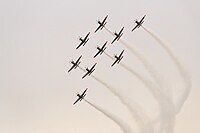Wikipedia:Image quality requirements
historical reference. . Either the page is no longer relevant or consensus on its purpose has become unclear. To revive discussion, seek broader input via a forum such as the village pump |
| This page in a nutshell: All images that are placed in an article should be clear enough to show what they are trying to illustrate |
The following is a proposal with an attempt to gain discussion regarding the minimum quality standards an image should meet in order to be placed in any mainspace article. While there is presently no guidline, images that fail to meet certain standards have been and continue to be challenged and removed by such editors, although whether these standards have universal support is unknown.
Unlike an article, which can only be deleted via the
The purpose of this proposal
The purpose of this proposal is to set a guideline as to a minimum standard of image quality.
Some possible requirements are:
- An image must clearly be recognized as portraying what it is supposed to at the size provided in the article
- An image must clearly be recognized as portraying what it is supposed to at its maximum resolution to which it can be enlarged on the screen
- An image must appear to plausibly be what it is portraying
Temporary use:
- Regarding the temporary use of an image not meeting the agreed requirement
- An imperfect image not meeting the agreed the agreed quality requirement may not be used in an article, even temporarily
- An imperfect image not meeting the agreed the agreed quality requirement may be used temporarily until a better image can be obtained. Under this guideline, "total blur" would still be excluded.
Ability to recognize
When displaying a person or object, the image should be clear enough that one who is either familiar with its appearance already can recognize what or who it is. If the picture is too dark, too light, blurry, or has other issues that cast doubt upon this recognition, the image should be removed from the article, and in some cases, may be deleted.
Images of nearly total blur
Images that are completely blurry, fuzzy, or smudged, too dark or light, or otherwise extremly unclear to the point that no one can make out the details of what is in them cannot be used at all in any articles in which the object shown in the image is important. An exception is when the blurriness or other trait that makes the image illegible is significant in illustrating what is in the article.
Legibility of characters

In an image that has letters, numbers, or symbols within it, when this is a detail that is important in portraying the object in relation to the article or section, those letters/numbers/symbols should clearly be legible at an available resolution. If the letters cannot be made legible, the image should be removed from the article. However, if other clear details of the image are useful within another article, the image may be used there.
Where images can or cannot be used

Some images, based on these guidelines, may be acceptable to be used in one article or section, but not within another. For example, an image showing the skyline of a city from a distance may be used in an article describing that city. However, it may not be used in an article about a building within that city if that building is a minor detail in the skyline that does not stand out.
Verifiability of images

Some images may be easy to verify. For example, it is possible to confirm that an image of a person or building is correctly that person or building, since other sources exist to compare. But a picture of a river or lake may be harder to verify, because no matter how much you compare, many others look identical. When such verification is impossible, editors are trusted to use correct images and not to pass off an image of one as another.
When no image is better
If the only image available clearly does not meet these requirements, it is better that the article not contain any image at all. But if the image just barely meets these requirements while there is room for improvement, the image may remain until a better one is found to replace it.
